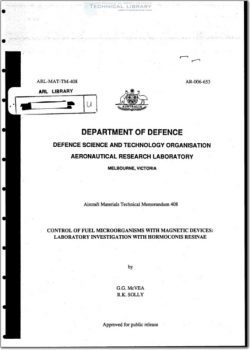DSTO-AR-006-653

- Version
- 185 Downloads
- 1.01 MB File Size
- 1 File Count
- August 10, 2016 Create Date
- August 10, 2016 Last Updated
Defence Science and Technology Organization Aeronautical Research Laboratory

Middle distillate fuels, such as aviation kerosene and diesel fuel, are
susceptible to degradation by microbiological growth in the fuel. Smaller gasoline
molecules are not so readily utilized as an energy source by microorganisms. Heavier
fuel oils generally contain non-hydrocarbon molecules which act as biostats for
microorganisms. Lubricating oils may also become infected with microbiological
growth.
The microorganisms occur naturally at low levels in the environment. It is
only when conditions are favourable for their growth and multiplication that they
become a problem. Water is an essential requirement for the propagation of
microorganisms and static systems where fuel is stored for long periods allow higher
populations to develop. Highest populations of fuel microorganisms are generally
found at fuel/water interfaces and removal of all free water from fuel systems is an
effective means of controlling microbiological growth.
Many microorganisms may be isolated from fuel. Sulphate-reducing bacteria
convert sulphur species to hydrogen sulphide, "rotten egg gas" - characterised by its
V smell - which is very poisonous at concentrations slightly greater that the level it may
be detected by its odour. Fungi, especially HORMOCONIS resinae (often known by
its previous name of Cladosporium resinae) forms mats of slimy mycelia matter,
which has a very high propensity to block fuel filters, especially in the presence of
organic fuel degradation products [1]. In addition the fungi (and the sulphate
reducing bacteria) form acidic metabolites which greatly accelerate the corrosion of
the metal fuel tank. The electrochemical micro-environment of aqueous mats of fungi
in contact with metal fuel tanks often leads to rapid pit corrosion of the fuel tank.
Avoiding the presence of water in fuel tanks is the most effective means of
microbiological control. This can only be attained by regularly draining water from
the fuel system as the ingress of water vapour and the subsequent condensation of
water in the fuel can not be avoided for air-breathing tanks. Water is present during
refinery processing and warmer fuel solubilizes more water. Fuel tanks in which free
water is not, or cannot be removed, often become heavily infected with
microorganisms, especially when the fuel is not being regularly replenished, which
maintains microbiological populations at a lower level.
| File | Action |
|---|---|
| DSTO-AR-006-653 Defence Science and Technology Organization Aeronautical Research Laboratory.pdf | Download |

Comment On This Post